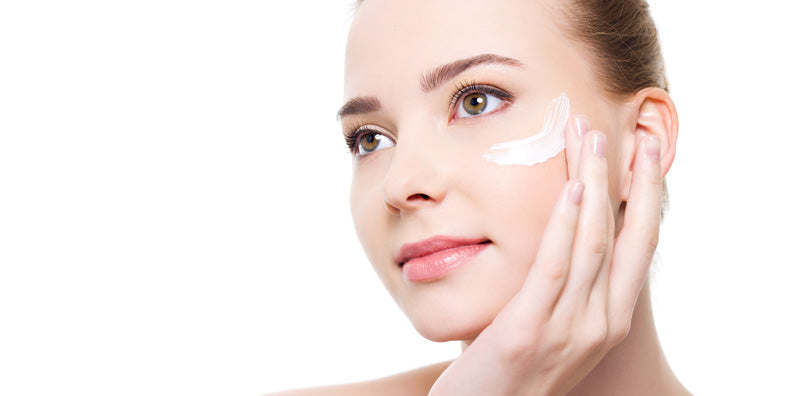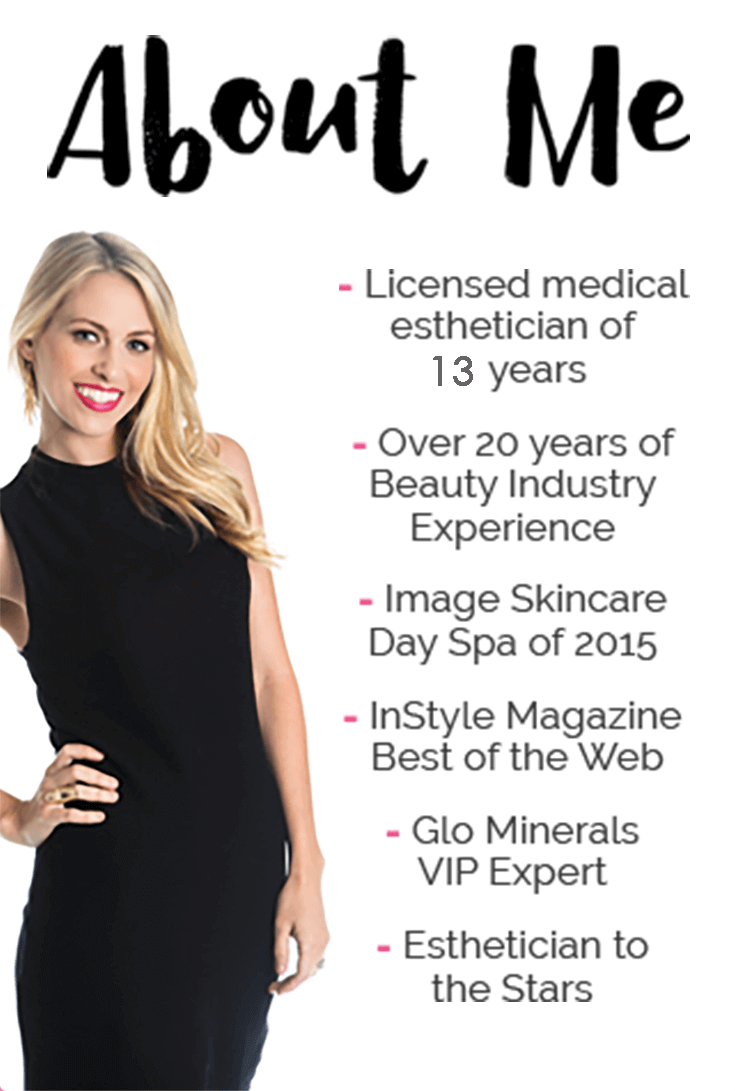What Should You Be Using In Your Skin Care Routine?
Take my quiz and get personalized recommendations from a
licensed esthetician!
What Are These Small White Bumps on My Face?
We'd all love for our face to be a smooth, blank canvas for applying our favorite products.
A recent online survey by Harris Interactive and Neutrogena asked 1,018 women over the age of 18 about their expectations of makeup and skincare products.

So what do we do if we have tiny bumps on our skin that won't go away?
They don't look like pimples...so what are they?
Today, I'm addressing a common skin condition that leaves our skin with a less than perfect texture - milia.
While milia are annoying, they're nothing to be concerned about.
Don't fret, beauties!
I'm going to explain what causes it, who gets it, and what you can do about it.
Let's get started!

What Are They?
Milia are harmless little white cysts (milium for just one) filled with a protein called keratin, which is found in skin, hair, and nail cells.
They are typically 1-2 millimeters in size.
When dead skin cells from the stratum corneum (the outermost layer of the epidermis) build up underneath the skin, a pearl-like bump forms.
In more simple terms, Dr. Cynthia Bailey states, "Milia are just a pocket of normal skin that somehow indented, sealed over, and the dead cells got trapped."
There's your science lesson for the day!
How to Identify
As the title of this blog states, milia are small white bumps that occur on the face, particularly around the eyelids, nose, mouth, and cheeks.
Your dermatologist or esthetician will be able to diagnose milia based on appearance.

Although it's more uncommon, they can also pop up on the scalp, back, chest, upper arms, and back of the hands.
They feel firm and look similar to whiteheads, but they aren't a member of the pimple family.
Milia don't form from a pore and shouldn't cause pain, redness, swelling, or inflammation.
However, they may cause itching in some individuals.
(If milia are causing intense itching or are irritated, see your dermatologist.)
What's the Cause?
Milia form as a result of the skin's inability to naturally exfoliate in certain areas.
It can be difficult to narrow down one specific reason why this happens.
While anyone can get milia at any age (known as primary milia), it's most common in babies (known as neonatal milia).

According to the Stanford School of Medicine, 40 percent of newborns experience it.
This is because their new, delicate skin is still learning to exfoliate.
I should mention that neonatal milia will go away on its own and doesn't require any treatment, but if you're truly concerned, ask your pediatrician.

As you can see, it might be difficult to narrow down one specific cause.
Different Types of Milia
In addition to primary and neonatal milia, here are the other types of milia that can occur:
- Secondary milia: develop as a result of damage or injury anywhere on the body.
- Multiple eruptive milia: rare; patches of milia appear on the face, arms, and upper torso over a period of weeks or months.
- Milia en plaque: rare; milia develope on a raised, inflamed patch of skin known as plaque.
How to Treat and Prevent
Many of us get the urge to POP, POP, POP at the first sign of any sort of bump on the skin.
I know, I know - it's tempting!
Who doesn't want a quick and easy fix to their skin woes?
You've heard this before, but don't pop, pick, or scratch!
Seriously. (Yes, I'm looking at you.)
Especially because milia can't be popped.
Smaller milia can go away on their own over time, and you can use products to help expedite the process.
But in some cases, you need professional help.
More on this in a second!
In the end, an aggressive approach may exacerbate the problem, leaving your skin more angry and upset than it was in the first place.
Worst case scenario: You'll damage your skin and risk scarring and infection, particularly if milia are on your eyelids.
Proper treatment and prevention may take more time and patience, but your skin will thank you in the end.
Visit your dermatologist or medical esthetician if you want to get gung-ho about treatment.
They'll have access to strong ingredients and help you decide which option is best:
- Chemical peel - acids are applied to the skin that cause it to exfoliate and eventually peel off, revealing the new, smooth layer underneath. There are three levels of peels: superficial, medium, and deep.
- Microdermabrasion - a machine with a tip made of diamond or fine crystal is used to remove dead skin cells to reveal a vibrant complexion. Some machines may use a suctioning function that vacuums the skin.
- Dermaplaning - a 10 gauge scalpel is used to gently scrape off the top layer of dead skin cells to resurface the skin and eliminate dullness.
- Extraction - a sterile needle or blade is used to create a small opening in the cyst, which is then removed by a tool called a comedone extractor.
- Cutaneous cryosurgery - done by a dermatologist, freezing temperatures are applied via a dipstick, probe, or spray techniques. A blister will form hours later, which will scab over and fall off after 1-2 weeks.
You might've seen those gross - yet satisfying - videos of professional milia removal online.
You can also find steps for DIY milia removal at home with a quick Google search.
I strongly advise against this!
Trying to do a mini surgical procedure on yourself won't end well, trust me.
Cleanse and Exfoliate
Thoroughly cleansing your skin every night is the most important (and easiest) prevention method!
I get it - as a mom of two boys and a business owner, there are some nights where I just don't want to keep my eyes open any longer than I need to.
But properly removing your day's worth of products from your face -- such as sunscreen, primer, foundation, mascara, and eyeliner - is so important.
It removes dirt, bacteria, buildup, pollutants, and free radicals from the skin, which can contribute to premature aging.

Think of the time and money we spend treating these problems (and the stress they cause) when they could have been avoided in the first place!
As a society, we're definitely reactive instead of proactive when it comes to our skin.
Below are my 3 keys to proper cleansing:
- You can start with a pre-cleanse to remove makeup, like micellar water, a gentle makeup remover, or an oil-based cleanser. This ensures your cleanser doesn't just spread everything around and clog your pores.
2. Then move on to the next step: a gentle foaming or cream cleanser, depending on your skin type.

3. You should also use a gentle cleanser/exfoliator combo 2-3 times a week.
This encourages new cell turnover and keeps pores clog-free.
Now, for a little bit about exfoliants.
There are two types you can use at home:
- A physical exfoliator uses small granules (like sugar) to buff away dead skin cells.
- A chemical exfoliant (not as harsh as it sounds) uses acids or natural fruit enzymes to dissolve and remove dead skin. I would opt for this one!
Personally, I'm also a big fan of cleansing devices and brushes used with a gentle cleanser (a form of physical exfoliation).
And hey, if you really can't stay awake, makeup remover wipes are better than nothing!
Keep them on your nightstand in case this happens.
Side note: Since milia can pop up on other areas of the body besides the face, I recommend exfoliating with a gentle body scrub or a soft bristle body brush and body wash.
Here's a great DIY recipe to use while you're in the shower!
Coffee Grounds Body Scrub
- 1 cup coffee grounds
- 1 cup coconut oil
- 1/2 cup white or brown sugar
Mix the ingredients together thoroughly. Massage the scrub onto wet skin and rinse with warm water.
The gentle exfoliation will leave your skin soft and smooth.

Look for Lightweight Moisturizing Formulas
Using a thick cream or slathering on a rich moisturizer every night can actually backfire.
These formulas can trap dead skin cells under the surface, contributing to the formation of milia.
Instead, choose hydration without the heaviness.
Look for non-comedogenic on the label (meaning the formula won't clog pores).
Also, check the ingredient list for humectants such as hyaluronic acid and consider adding a serum to your routine.
Made with a higher concentration of ingredients that target specific skin concerns, a serum will deliver deep moisture to your skin in a lightweight formula.
Layer your moisturizer on top of the serum so it can be absorbed.

Wear Your SPF Every Day
I think I mention this in nearly every blog post because it's that important!
Wearing a broad-spectrum sunscreen of at least SPF 30 every single day will keep your skin healthy, prevent aging and wrinkles, and protect against skin cancer.
If that isn't motivating enough, milia can form due to a prolonged history of sun damage.
The epidermis becomes thicker, making it harder for dead skin cells to be shed.
Now, more about prevention and protecting your skin.
There are two types of sunscreens:
- Physical: minerals, like zinc oxide and titanium dioxide, sit on the skin and reflect UVA and UVB rays. This is my personal choice of sunscreen formula.
- Chemical: organic compounds, like avobenzone and oxybenzone, absorb the sun's rays and release heat from the skin.
We know that sunscreen is good for us, but finding the right formula and adding another step into our morning routine can seem daunting and time-consuming.
My advice?
Use a product that does double duty, like a tinted moisturizer with SPF 30 included. 2 steps in 1!
Use Effective Ingredients
Over the counter ingredients get the job done, too!
The milia will eventually come to the surface.
It might just take a little longer than an in-office procedure (but will cost less).
Below are some superheroes that will combat pesky milia:
- Glycolic acid - an alpha hydroxy acid (AHA) that gives skin a mild exfoliating effect, encourages cellular turnover, and gently removes the top layer of dead skin cells.
- Lactic acid - this AHA is more gentle than glycolic acid to exfoliate to stimulate cell turnover and soften and improve skin texture.
- Retinoids - this vitamin A derivative exfoliates and dissolves dead skin.
- Salicylic acid - a beta hydroxy acid (BHA) that cleanses and unclogs pores by breaking up dead skin cells.
These ingredients are used in toners, lotions, spot treatments, or face washes.
You can also find at-home peels with these wonderful ingredients.
They help dissolve the top layer of your skin safely and without harshness.
They can be used once or twice a week, but make sure to stop at the first sign of irritation.
It's really up to you (and your skin type) to decide the treatment route.
Treat Yourself
You have a reason to go get a facial regularly!
Or, you can do it yourself.
Your esthetician can choose the right products with the right ingredients to treat and prevent milia.
How often you receive a facial will depend on your skin's needs.
Facials address other skin concerns, too - and they also come with a ton of benefits!

I could sure use one right now!

Makeup Application
Your glam routine probably isn't contributing to milia formation.
This means you don't have to stop wearing makeup!
Whether you need concealer or liquid or powder foundation, I recommend a lightweight, non-comedogenic, oil-free, and scent-free formula. Phew!
Makeup doesn't have to exacerbate the appearance of milia, either.
I recommend strategic application using your fingers, brush, or a sponge.
Just remember to regularly clean them!
My general advice is to gently dab and/or blend in a circular motion - don't rub!
Keep on reading for products that will assist you in the battle of the bumps.
Product Roundup

Alana Mitchell 4-in-1 Cleansing Pod
 Epicuren 5% Clear Glycolic Skin Peel
Epicuren 5% Clear Glycolic Skin Peel
Alana Mitchell Daily OC Cream Cleanser
Image Skincare Clear Cell Salicylic Clarifying Tonic
Alana Mitchell Hyaluronic Moisture Boost Serum
Dermaquest DermaClear Spot Treatment
Alana Mitchell Night R1 Facial Oil
Epicuren Fine Herbal Facial Scrub
 Image Skincare Prevention+ Daily Hydrating Moisturizer
Image Skincare Prevention+ Daily Hydrating Moisturizer
Final Thoughts
Small white bumps on the face can be annoying and even cause worry.
We might search for ways to immediately get rid of them.
I'm here to reassure you that although they're annoying, milia are harmless and common.
Don't let them distract you from your inner and outer beauty!
You are gorgeous either way!
As long as you're taking proper care of your skin, you got this!
Beauties, have you dealt with milia before? What was your experience? Share with us in the comments!
Top Brands
New Brands

Recent Posts

Are You Taking the Right Steps to Care for Your Skin?
Take the Quiz
Skincare Secrets!
10-step guide for healthy, beautiful skin after kids.
100% privacy. I will never spam you!



















